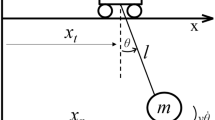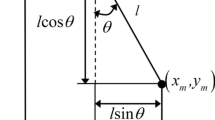Abstract
In this paper, a modified salp swarm algorithm (SSA) based active disturbance rejection control (ADRC) controller is designed to improve anti-interference and anti-sway control performance for overhead crane systems. Aiming at the ADRC parameter setting problem, the modified SSA is introduced with several methods including the parameter adjustment scheme, adaptive evaluation mobile strategy, opposition-based learning (OBL) strategy and disengagement strategy. By implementing numeric experiment tests, the effectiveness of the modified SSA is confirmed by benchmark functions. Finally, by implementing the simulation experiments under different conditions, the results show that the modified SSA algorithm based ADRC controller has significantly improved the suppression of load swing and position control as well as the anti-interference.











Similar content being viewed by others
References
Al-Greer, M., Armstrong, M., Pickert, V.: Selecting appropriate fuzzy PID control structure for power electronic applications. J. Eng. 2019, 4457–4460 (2019)
Bhandari, A.K., Kandhway, P., Maurya, S.: Salp swarm algorithm-based optimally weighted histogram framework for image enhancement. IEEE Trans. Instrum. Meas. 69, 6807–6815 (2020)
Chen, Z., Zha, H., Peng, K., Yang, J., Yan, J.: A design method of optimal PID-based repetitive control systems. IEEE Access 8, 139625–139633 (2020)
Hai, X., Wang, Z., Feng, Q., Ren, Y., Xu, B., Cui, J., Duan, H.: Mobile robot ADRC with an automatic parameter tuning mechanism via modified pigeon-inspired optimization. IEEE/ASME Trans. Mechatron. 24, 2616–2626 (2019)
Han, J.: From PID to active disturbance rejection control. IEEE Trans. Ind. Electron. 56, 900–906 (2009)
Köse, E.: Optimal control of AVR system with tree seed algorithm-based PID controller. IEEE Access 8, 89457–89467 (2020)
Li, H., Cheng, L., Li, Z., Xue, W.: Active disturbance rejection control for a fluid-driven hand rehabilitation device. IEEE/ASME Trans. Mechatron. 26, 841–853 (2021). https://doi.org/10.1109/TMECH.2020.3006364
Liu, X., Xu, H.: Application on target localization based on salp swarm algorithm. In: 37th Chinese Control Conference (CCC), vol. 2018, pp. 4542–4545. IEEE (2018)
Liu, J., Sun, M., Chen, Z., Sun, Q.: High AOA decoupling control for aircraft based on ADRC. J. Syst. Eng. Electron. 31, 393–402 (2020)
Mirjalili, S., Gandomi, A.H., Mirjalili, S.Z., Saremi, S., Faris, H., Mirjalili, S.M.: Salp swarm algorithm: a bio-inspired optimizer for engineering design problems. Adv. Eng. Softw. 114, 163–191 (2017)
Mohapatra, T.K., Dey, A.K., Sahu, B.K.: Employment of quasi oppositional SSA-based two-degree-of-freedom fractional order PID controller for AGC of assorted source of generations. IET Gener. Transm. Distrib. 14, 3365–3376 (2020)
Nayak, J.R., Shaw, B., Sahu, B.K.: Implementation of hybrid SSA-SA based three-degree-of-freedom fractional-order PID controller for AGC of a two-area power system integrated with small hydro plants. IET Gener. Transm. Distrib. 14, 2430–2440 (2020)
Qi, Z., Shi, Q., Zhang, H.: Tuning of digital PID controllers using particle swarm optimization algorithm for a can-based DC motor subject to stochastic delays. IEEE Trans. Ind. Electron. 67, 5637–5646 (2019)
Shen, J., Xin, B., Cui, H., Gao, W.: Control of single-axis rotation ins by tracking differentiator based fuzzy PID. IEEE Trans. Aerosp. Electron. Syst. 53, 2976–2986 (2017)
Sun, Z., Ling, Y., Sun, Z., Bi, Y., Tan, S., Ding, L.: Designing and application of fuzzy PID control for overhead crane systems. In: 2019 2nd International Conference on Information Systems and Computer Aided Education (ICISCAE), IEEE, pp. 411–414 (2019a)
Sun, H., Ma, R., Deng, S., Li, L., Zhang, J., Qi, Y., Feng, Y., Zhang, T.: Research on dual-mode switching fuzzy PID servo algorithm based on micro-linear motor. J. Eng. 2019, 8927–8931 (2019b)
Tizhoosh, H.R.: Opposition-based learning: a new scheme for machine intelligence. In: International Conference on Computational Intelligence for Modelling, Control and Automation and International Conference on Intelligent Agents, Web Technologies and Internet Commerce (CIMCA-IAWTIC’06), vol. 1, pp. 695–701. IEEE (2005)
Verma, B., Padhy, P.K.: Robust fine tuning of optimal PID controller with guaranteed robustness. IEEE Trans. Ind. Electron. 67, 4911–4920 (2019)
Wang, Z., Zu, R., Duan, D., Li, J.: Tuning of ADRC for QTR in transition process based on NBPO hybrid algorithm. IEEE Access 7, 177219–177240 (2019)
Wu, X., Xu, K., Lei, M., He, X.: Disturbance-compensation-based continuous sliding mode control for overhead cranes with disturbances. IEEE Trans. Autom. Sci. Eng. 17, 2182–2189 (2020)
Xiao, B., Wang, R., Xu, Y., Song, W., Wang, J., Wu, Y.: Salp swarm algorithm based on particle-best. In: IEEE 3rd Information Technology, Networking, Electronic and Automation Control Conference (ITNEC), vol. 2019, pp. 1383–1387. IEEE (2019)
Zhang, H.-Y., Wang, J., Lu, G.-D.: Hierarchical fuzzy-tuned multiobjective optimization control for gantry cranes. Proc. Inst. Mech. Eng. C J. Mech. Eng. Sci. 228, 1119–1131 (2014a)
Zhang, H.-Y., Wang, J., Lu, G.-D.: Self-organizing fuzzy optimal control for under-actuated systems. Proc. Inst. Mech. Eng. Part I J. Syst. Control Eng. 228, 578–590 (2014b)
Zhang, Y.-L., Zhu, M., Li, D., Wang, J.-M.: ADRC dynamic stabilization of an unstable heat equation. IEEE Trans. Autom. Control 65, 4424–4429 (2019)
Acknowledgements
This work was supported in part by the National Natural Science Foundation of China under Grant 62022044, 61972208 and 61803213, in part by the Jiangsu Natural Science Foundation for Distinguished Young Scholars under Grant BK20190039, National Key Research and Development Project of China (Research on key Technical standards of Green Logistics, No.2017YFF0208703).
Author information
Authors and Affiliations
Corresponding author
Additional information
Publisher's Note
Springer Nature remains neutral with regard to jurisdictional claims in published maps and institutional affiliations.
Appendix A. Analysis of the stability of the proposed ADRC
Appendix A. Analysis of the stability of the proposed ADRC
1.1 Appendix A.1. Preliminary
In order to analyse the stability of the proposed ADRC, we first simplify overhead crane system.
By appropriately selecting TD and ESO, as well as nonlinear functions and parameters in nonlinear combinations, ADRC can control a broad class of uncertain objects:
The state-space design of the overhead crane is simplified as follows:
Constructing the ESO, where \(g_{i}\left( z_{1}-y\right)\) Is a nonlinear function:
Specifically, the nonlinear function is:
and
The nonlinear state error feedback is:
1.2 Appendix A.2. Analysis of the stability of the proposed ADRC
The ADRC is simplified as follows:
-
1.
Let the input be zero (\(y_{0}=0\)), then the output of TD is zero.
-
2.
Change the nonlinear state error feedback to linear error feedback:
$$\begin{aligned} u=\sum _{i=1}^{4} k_{i} z_{i}-\frac{z_{5}}{b} \end{aligned}$$(27) -
3.
Choose the same non-linear function in ESO \(\varphi (x)\), where \(x \varphi (x)>0\), \(x \ne 0\) ;and let \(\varphi \in F\left( \mu _{1}, \mu _{2}\right)\) where \(\varphi (0)=0\) and \(\forall x \ne 0\), \(\varvec{\mu }_{1} x^{2}<x \varphi (x)<\mu _{2} x^{2}\) then \(x \varphi (x)>0\), namely \(\varphi (x) \in F(0,+\infty ]\), then:
$$\begin{aligned} \left\{ \begin{array}{l}\dot{z}_{1}=z_{2}-\beta _{1} \varphi \left( z_{1}-y\right) \\ \dot{z}_{2}=z_{3}-\beta _{2} \varphi \left( z_{1}-y\right) +b u \\ \dot{z}_{3}=z_{4}-\beta _{3} \varphi \left( z_{1}-y\right) +b u \\ \dot{z}_{4}=z_{5}-\beta _{4} \varphi \left( z_{1}-y\right) +b u \\ \dot{z}_{5}=-\beta _{5} \varphi \left( z_{1}-y\right) \end{array}\right. \end{aligned}$$(28) -
4.
Let the overhead crane be a linear time-invariant object:
$$\begin{aligned} \begin{aligned} x^{(4)}=-a_{4} x-a_{3} \dot{x} -a_{2} \dot{x}^{(2)} -a_{3} \dot{x}^{(3)}+bu \\ y=x \end{aligned} \end{aligned}$$(29)
Substitute Eqs. (27) and (29) into Eq. 22, let \(X=\left[ \varvec{x}_{1}, \varvec{x}_{2},\varvec{x}_{3} , \varvec{x}_{4}\right] ^{\mathrm {T}}\) , \(Z=\left[ \varvec{z}_{1}, \varvec{z}_{2},\varvec{z}_{3} , \varvec{z}_{4}\right] ^{\mathrm {T}}\), we get:
where \(a_{13}=[0, 0, 0,-1]^{\mathrm {T}} \in R^{4}\), \(A_{11}=\left[ \begin{array}{cccccc}0 &{} 1 &{} 0 &{} &{} 0 \\ 0 &{} 0 &{} 1 &{} &{}0 \\ \ 0 &{}0 &{} 0 &{} &{} 1 \\ -a_{4} &{} -a_{3} &{}-a_{2} &{} &{} a_{1}\end{array}\right]\), \(A_{12}=\left[ \begin{array}{cccccc}0 &{} 0 &{} 0 &{} 0 \\ 0 &{} 0 &{} 0 &{}0 \\ \ 0 &{}0 &{} 0 &{} 0 \\ -bk_{1} &{} -bk_{2} &{}-bk_{3} &{} -bk_{4}\end{array}\right]\) Substituting Eq. (27) into Eq. (28), we can get:
where \(b_2=\left[ \varvec{\beta }_{1}, \varvec{\beta }_{2},\varvec{\beta }_{3} , \varvec{\beta }_{4}\right] ^{\mathrm {T}}\), \(A_{22}=\left[ \begin{array}{cccccc}0 &{} 1 &{} 0 &{} 0 \\ 0 &{} 0&{} 1 &{}0 \\ \ 0 &{}0 &{} 0 &{} 1 \\ -bk_{1} &{} -bk_{2} &{}-bk_{3} &{} -bk_{4}\end{array}\right]\)
By combining Eq. (30) with Eq. (31), we can get:
where \(c_{1}=[-1, 0, 0,0]^{\mathrm {T}} \in R^{4}\), \(c_{2}=[1, 0, 0,0]^{\mathrm {T}} \in R^{4}\) let \(Y=A_{11} X+a_{13} z_{5}, z_{5}^{\prime }=z_{5} / \beta _{5}\) we get
Equation (33) conforms to a standard form of the first critical case of absolute stability, namely:
where \(A=\left[ \begin{array}{cc}A_{11} &{} A_{11} A_{12} \\ 0 &{} A_{22}\end{array}\right] \quad b=\left[ \begin{array}{l}a_{13} \beta _{5} \\ \quad b_{2}\end{array}\right]\), \(c^{\mathrm {T}}=\left[ \begin{array}{ll}c_{1}^{\mathrm {T}} A_{11}^{-1}&c_{2}^{\mathrm {T}}\end{array}\right]\), \(\rho =-c_{1}^{\mathrm {T}} A_{11}^{-1} a_{13} \beta _{5}=\frac{\beta _{5}}{a_{4}}\)
The necessary condition for the absolute stability of the solution of \(F(0,+\infty ]\) zero for system expression (34) is: \(\text{ Re } \lambda (A)<0, \rho >0\).
If the linear time-invariant object is asymptotically stable, that is, all eigenvalues of \(A_{11}\) have A negative real part, and the selected parameter \(k_{I}\) guarantees that all eigenvalues of \(A_{22}\) have A negative real part, then the eigenvalues of A have A negative real part, so the following conclusion can be drawn:
The necessary conditions for the absolute stability of ADRC system Eq. (33) are that the linear steady-state object is asymptotically stable and the controller parameter is greater than zero and that \(\text {Re} \lambda \left( A_{22}\right) <0\). A Lyapunov function is constructed, which has the form of quadratic plus nonlinear integral:
If P is a positive definite matrix, \(\alpha , \beta \geqslant 0\), then U(x, y)is a positive definite function.
Equation (35) by taking the total derivative of Eq. (34) with respect to t, we can get:
let \(Q=-P A-A^{\mathrm {T}} P\), \(d=P b-\left( \alpha \rho c+\frac{1}{2} \beta A^{\mathrm {T}} c\right)\),\(\gamma =\beta \left( \rho +c^{\mathrm {T}} b\right)\). Because \(y \varphi (y)> 0, \rho = \left( \beta _ {5} / a_ {4} \right) > 0\), as long as \(\alpha \geqslant 0\)and the first three entries of Eq. (36) are positive definite quadratic of X and N +1 variables of \(\varphi\), then \(\dot{U}\)must be negative definite, thus ensuring the global asymptotic stability of the zero solution of Eq. (34).
Rights and permissions
About this article
Cite this article
Sun, Z., Zhou, J., Ling, Y. et al. Designing and application of modified SSA based ADRC controller for overhead crane systems. Int J Intell Robot Appl 6, 449–466 (2022). https://doi.org/10.1007/s41315-021-00207-x
Received:
Accepted:
Published:
Issue Date:
DOI: https://doi.org/10.1007/s41315-021-00207-x




